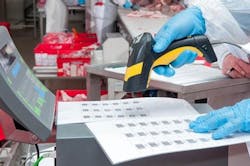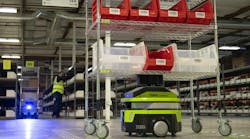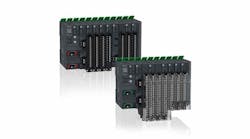Future-Proofing Manufacturing with the Cloud
By Lee Patty, VP & General Manager, NiceLabel Americas
A recent study from the American Productivity & Quality Center (APQC) found that 95% of supply chain professionals believe enterprise digitization will have a major impact on supply chain management over the next three years.
The same study also identified the top challenges supply chain pros face – from new regulation requirements to a lack of information sharing, too small a budget, and even a limited workforce, just to name a few. And when you factor in other concerns, such as supply chain constraints, growing competition on a global scale and increasing customer expectations, it’s easy to see why manufacturers are in dire need of methods and tools to reduce costs and standardize processes.
While technology can help address these pain points, one of the most overlooked – and critical – components is having the right barcode labeling systems. It could be the key to future-proofing your business.
Think about it: regardless of industry, every product’s labels must be compliant, transparent and traceable across country borders. Needless to say, this process generates massive amounts of data, which must be easily decipherable by everyone – from all internal departments, such as IT, manufacturing, logistics, to suppliers, customers and, finally, consumers. How can productivity, quality, and accuracy be guaranteed amidst so many different stakeholders and label types?
Labeling systems roadblocks and the need to break down silos
Labeling has historically been given a reactive treatment. This means that unless it caused a problem, most companies have not paid much attention to it. And due to a lack of proactivity, it has been common for each distribution center, factory or other facility to produce its own labels for inventory control, shipments, and other processes. This has led to a silo-effect, where each facility may have its own labeling software along with a multitude of different label printers. Because such disparate organization has been often overlooked, many organizations still fail to see the costs associated with a dislocated network and process for labeling. Trust me, it’s HUGE.
When labeling is unorganized, simple tasks like a shipment label change not only become arduous but also potentially damaging to your brand and consumer safety. As common sense can dictate, a decentralized system will inevitably increase inaccuracies, such as mislabeled products – a leading cause of recalls.
Consider that, per Food Safety Magazine, 2018 saw at least 160 recalls due to mislabeled allergen information, and it’s very often that we hear stories like a recent case this year where nearly 100,000 lb. of mislabeled chicken were recalled by a major producer. These are potentially disastrous consequences, but inaccuracies can also have more subtle consequences, such as quality degradation, the risk of errors leading to non-compliance and latency, and having to use highly paid employees to change your label templates, especially when printer command scripting is required.
Going digital and centralizing the labeling process
Digitally transforming labeling with the cloud enables organizations to centralize and control labeling processes, from any location. Whether the labels are needed at the distribution center, factory or at another facility, they can be produced, changed or updated from a browser and accessed by anyone where they are needed.
A centralized modern labeling system can enhance your quality and agility, reduce costs and promote better supply chain cooperation within your organization.
- A centralized solution drastically raises quality
Whether marketing, production or IT creates them, will be much more consistent with a centralized solution. This consistency pays dividends towards maintaining a congruent brand image and compliance, and the customers will also benefit from consistency in terms of quality assurance and formatting.
Centrally housing only one version of each template guarantees proper integration with your ERP or MES, and it reduces chances for human error. Furthermore, organizations can address product counterfeiting with multiple levels of role-based security, so users can have restricted access, and make changes, to only the files they need.
- Reduced IT dependence means nimbler labeling
Cutting the need for high-level expertise enables quick and easy processes for creating change requests and new label templates. This is where a cloud-based label management solution comes in handy. By digitizing and automating processes, users without programming knowledge can produce labels in a few hours, instead of waiting weeks for IT. Whether workers are in production, shipping, marketing, quality assurance or other departments – all parties can easily print labels with the assurance that they will print consistently on the printer available at their location.
- Leaner operations cut manual labor and lower costs
Redundant, manual tasks create unnecessary costs. And it’s not uncommon for enterprises to have thousands of label files spread across facilities, and even many duplicates for the same customer. Centralization eliminates duplicate files, saving you costs associated with maintaining them while reducing the probability of mislabeling and recalls.
By eliminating manual quality control, cloud-based label management systems digitize the quality assurance process. This reduces labor cost, and risk of error and enables changes to be approved more quickly.
- Move to a centralized cloud for unified collaboration
Centralized control streamlines collaboration with supply chain partners. Additionally, labels can be easily created and shared through a cloud-based label management system, which supports consistency in a supply chain while discouraging product counterfeiting and diversion.
Legacy labeling approaches, with disparate printing and manual processes, are no longer feasible. And these tips are just a starting point to help organizations compete in an increasingly connected world, where high-quality products require faster delivery to more markets.
Labeling must be standardized, digitized and integrated with logistics systems and manufacturing. The benefit is twofold, both increasing responsiveness and quality as well as reducing costs. And remember, it’s not just about efficiencies today – it’s about ensuring success tomorrow.
About the author:
Lee Patty is VP and General Manager at NiceLabel Americas. In this role, Lee oversees the company’s sales, project delivery, and operations in the Americas. Prior to NiceLabel, he co-founded Niceware International, LLC, a NiceLabel distributor, where he was responsible for marketing, healthcare product development and professional services. NiceLabel acquired Niceware in 2013, adding Lee to the global executive team. Lee has over 20 years of AIDC industry experience and has also held sales, marketing and technical roles at Brady Corporation and Innovatec Communications.





